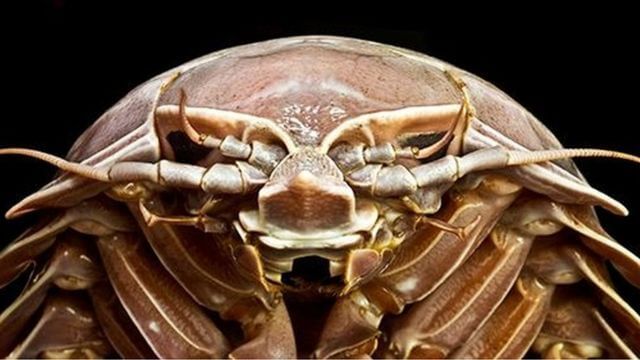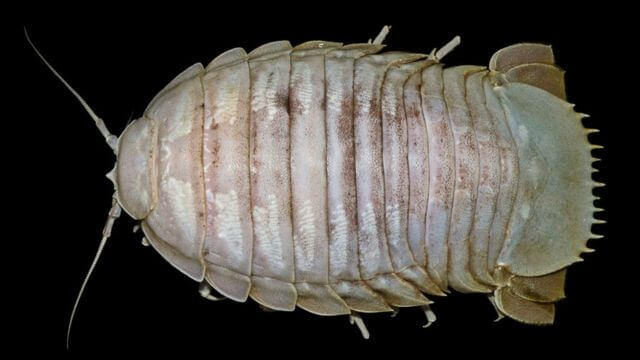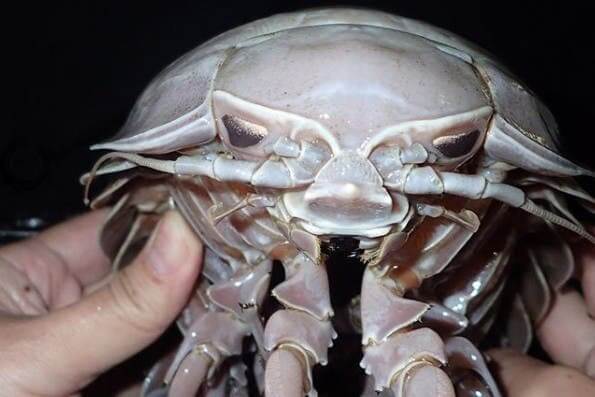"Gigantic Cockroach" Discovered at the Bottom of the Sea

For several years now, abyssal fauna has become popular, mainly due to the bizarre looks of some of them! This is the case with this crustacean, a “gigantic cockroach” that lives at the bottom of the sea. The surprises nature gives us never cease.
In this article, you can find out more about this finding, the species, and its characteristics. Don’t miss anything, because it’s just a sample of everything that the planet still hides from us. Let’s take a look.
The discovery of the “gigantic cockroach” from the seabed

It’s rare to find beautiful animals (according to our human way of defining beauty) in the depths of the ocean. In July 2020, yet another proof was discovered: a huge crustacean, almost half a meter long, with a close resemblance to cockroaches.
The discovery was made in Indonesian waters, south of Java, by a group of scientists exploring that area. The depth of the study was at an average of 800 meters (2200 feet), but the deepest point reached 2100 meters (nearly 7000 feet).
This species was identified within the genus Bathynomus, which groups 19 species of large crustaceans with similar shapes to those of our cockroach from the bottom of the sea. Let’s get to know it in detail.
The genus Bathynomus, giant mealybugs
The genus Bathynomus is made up of isopods, creatures that live in deep waters (mostly) and have flat bodies adapted to the conditions of marine abysses. Their appearance is similar to that of lice or mealybugs, as they are popularly known. Or, in this particular case, to cockroaches.
Of the 19 species that exist, 16 live in the Indo-Pacific. Of these 16, 7 were classified as “supergiant”, as they exceed 150 millimeters (6 inches) when mature and can reach 500 millimeters (20 inches). This new species was named Bathynomus raksasa, and was added to this list of “supergiant” species. In the following section, you can learn more about it in depth.
Bathynomus raksasa, giant and abyssal
This crustacean belongs to the order of isopods, the largest and most diverse of those that exist. They can be found in all types of environments and group together more than 10,000 species. The body of the isopods consists of head, thorax and abdomen. The thorax, in turn, is divided into 8 segments, each with its corresponding pair of legs.
Its scientific name comes from the Indonesian word for “giant”, raksasa.
Well, the Bathynomus raksasa shares all these characteristics and, on top of it, its size is enormous. Even so, it isn’t the largest known, but ranks second to Bathynomus giganteus.
This animal, similar to a cockroach living at the bottom of the sea, has developed some specific characteristics to withstand the conditions of the depths of the sea. Don’t miss them, as they’re fascinating.
Adaptations of Bathynomus raksasa to the abyssal ecosystem
Life on the seafloor is tough. Pressures are extremely high, light is scarce or non-existent and food is scarce for many species. That’s why it’s easy to find animals that have made these extreme environments their advantage, as is the case of Bathynomus raksasa:
- Its flattened body allows it to better withstand the high pressures of the abyssal zones: In addition, this animal moves along the seabed, so its morphology helps it to move more easily.
- Its diet is necrophagous: It feeds on the remains of dead animals that perish on the seabed or fall from the surface. This makes it a valuable cleaning agent of the ecosystem. On the other hand, this diet ensures its survival.
- Large eyes and long antennae: In the environments where it moves there’s little or no light, so these adaptations facilitate its development.
Why so huge?

On the other hand, the issue of its size is a controversial topic among scientists, since the rest of its congeners have been shrinking throughout evolution. The truth is that there are 3 theories:
- These isopods need to transport more oxygen due to the scarcity of oxygen in the deep sea. Remember that much of the oxygen in the water is provided by microalgae, which aren’t able to proliferate without sunlight for photosynthesis.
- They don’t have many predators: Unlike other species of the genus Bathynomus, this one hasn’t needed to reduce its size for reasons of survival against other animals.
- Their metabolism is incredibly slow to optimize their energy in an environment with scarce resources. This requires a larger-than-average body.
As you can see, this “gigantic cockroach” discovered at the bottom of the sea isn’t the first of its genus nor of its size. However, each new piece of the puzzle is one more step towards a deeper understanding of this gigantic ecosystem called Earth.
All cited sources were thoroughly reviewed by our team to ensure their quality, reliability, currency, and validity. The bibliography of this article was considered reliable and of academic or scientific accuracy.
- Sidabalok, C. M., Wong, H. P. S., & Ng, P. K. (2020). Description of the supergiant isopod Bathynomus raksasa sp. nov.(Crustacea, Isopoda, Cirolanidae) from southern Java, the first record of the genus from Indonesia. ZooKeys, 947, 39.
- Briones-Fourzán, P., & Lozano-Alvarez, E. (1991). Aspects of the biology of the giant isopod Bathynomus giganteus A. Milne Edwards, 1879 (Flabellifera: Cirolanidae), off the Yucatan Peninsula. Journal of Crustacean Biology, 11(3), 375-385.
